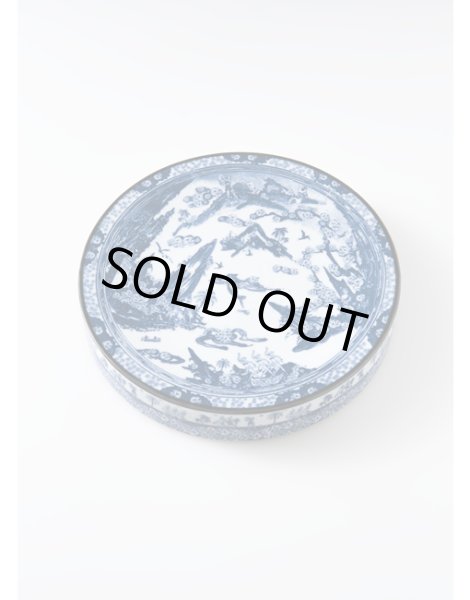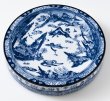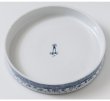円柱髑髏絵皿 [YY012]
販売価格: 22,000円(税込)
重さ: 4100g
商品詳細
※1点ずつ手作業にて全て制作しておりますので、納期に1ヵ月ほど時間がかかることがございますが予めご了承ください。納期にお日にちがかかる場合は追ってご連絡いたします。
商品ID:YY012
商品名:円柱髑髏絵皿
制作年:2012 素材:陶器 美濃焼
内容:水面皿1枚 サイズ:直径32.5cmX高さ5.5cm
○今回の『円柱髑髏絵皿』の制作にあたりまして 円柱皿(尺1寸)に下絵加工した銅版(素焼き用転写)をどのように貼り付けるか、非常に困難な作業でした。 まず最初に起こった問題は、円状の銅版(転写紙)をいかに切り離し、半円に加工しどこで合わせるのか、はたして最後にこれらをきれいに合わせることができるのか、ということでした。 銅版の出来上がりと数件の窯に持ち込み張りの依頼をしました。最初の出来上がりはしわが出たり(濃い部分に白い線)渕部分の線の合わせがずれて、(細い線が2重になる)焼きあがってしまいました。 銅版の貼り付け工程は素焼きの表面に銅版をあてがい、水分を含んだ布などで軽くたたきながら、素焼きに呉須色をしみこませる技法で、今ではオートメーションによる版押しが主流になっておりますが、今回のように『円柱髑髏絵皿』柄をイメージするに当たり、器の紋様を最大限に引き立てることができるのは手作業による工程を踏むしかございません。 さて次に渕黒線(黒呉須)の作業は紋様よりも困難でした、通常呉須色の絵柄の器の線は同じ呉須色か錆色を使います、黒呉須は線としてではなく柄(鳥のくちばしや羽、草木など細かい線)に使用します。 円柱皿の線の太さは約4mm、この太さですと通常は引けません、素焼きにしみ込む速度を調整しなおかつ刷毛(筆)に含む量を調整したり、使わない素焼きで色試験で焼成したりと紋様の貼り付けよりも時間を費やしました。 焼き上がりの皿は毎回黒呉須が煮えたり(細かい気泡が出る)刷毛にしみ込む量の違いで濃淡が出たりしたので、窯の中の温度差(下側、壁側、上側)があるのでどの場所が適温かも、試験しました。 陶器制作にあたり、窯それぞれ独自の釉薬を使います。はじめに出来上がった皿を比べた時、白地の釉薬の違いがはっきりと出ましたので、白地の釉薬を特注で精製してもらい、白地よりも薄い青(薄青磁)を下地の釉薬に使用しました。 釉薬、窯だしの時間、手作業による時間等様々な問題がありましたが、今回の器は手間暇とメーカーの情熱が注ぎ込まれた価値のある器となることができました。
■髑髏絵皿の制作につきまして
1.素焼き⇒お皿を成形し、250℃〜300℃の窯へいれる。
2.絵付け⇒美濃紙(障子紙のようなもの)に呉須(ごす。下絵に使うダークブルーの彩料。)で印刷された髑髏の絵柄をお皿に転写する。
3.本焼き⇒髑髏の絵だけが残ったお皿に白の釉薬(うわぐすり)を入れて本焼き(1200℃から1300℃で焼く)をすると呉須が浮かび上がり、白の釉薬が絵柄の間に残り、ダークブルーと白を基調とした独特の髑髏絵皿が完成。 ※1点1点全て手作業で作っております。
※Please understand that it may take about a month for delivery since each item is made by hand. We will contact you later if the delivery takes longer.
【NAME】 Plate with a skull and crossbones
【Contents & ID】 YY012
【SIZE】 1 surface dish Size:32.5cm (diameter) X 5.5cm (height)
【QUALITY】 Ceramic, Mino ware
○We have made this "Cylindrical Dish with a Skull on a Pillar" for the purpose of making this "Dish with a Skull on a Pillar".
It was a very difficult task how to attach a copper plate (transfer for unglazed ware) processed with underglaze painting on a cylindrical dish (1 inch in length). The first problem was how to cut off the circular copperplate (transfer paper), process it into a semicircle, and where to fit it together, and whether we could fit them neatly at the end.
Once the copperplates were finished, we brought them to several kilns and asked them to stretch them. The first result had wrinkles (white lines in dark areas) and the lines in the fuchi area were not aligned properly (double thin lines), and the piece was fired.
In the process of applying the copper plate, a copper plate is placed on the surface of the unglazed ware and lightly beaten with a moist cloth to make the color of Kuresu soak into the unglazed ware. However, in order to make the pattern of "Cylindrical Skull Plate", the only way to enhance the design of the dish is to do the process by hand.
The black line on the fuchi was more difficult than that of the pattern.
The thickness of the lines on a cylindrical dish is about 4 mm, and it is usually not possible to draw lines of this thickness, so more time is spent on adjusting the speed at which the lines soak into the unglazed ware, adjusting the amount of ink in the brush, and firing the unglazed ware for color tests.
The black gosuzu on the finished dish boiled every time (fine bubbles appeared), and the shade of the color varied depending on the amount of the brush that soaked into the black gosuzu.
Each kiln uses its own glaze for pottery production. When we first compared the finished plates, the difference in the white glaze was clear, so we had the white glaze refined by special order and used a lighter blue (light celadon) for the underglaze glaze. Although there were various problems with the glaze, the time required to start the kiln, and the time required to do the work by hand, this time we were able to create a worthy vessel with a lot of time, effort, and passion put into it by the maker.
■For the production of the Skull-painted Plate
1. Unglazed ⇒ The dish is molded and placed in a kiln at 250 to 300 degrees Celsius.
2. Painting ⇒ Gosu (dark blue color used for underglaze painting) is applied to Mino paper (similar to shoji paper). Gosu is a dark blue coloring used for underglaze painting.) The design of the skull is printed on Mino paper (like shoji paper) and transferred to the plate. 3.
3. baking ⇒ After baking at 1200 to 1300℃, white glaze is added to the plate with only the picture of a skull left on it, and the white glaze is left between the pictures.
※Each piece is made entirely by hand.







